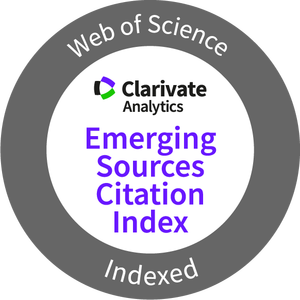Evidence based practice beliefs and implementation among Egyptian physical therapists: A cross-sectional study
Abstract
Adding evidence-based practice (EBP) to physical therapists (PTs) routine practice enhances work environment, healthcare quality and rehabilitation outcomes. Physiotherapy is one of the most developed healthcare professions especially in the last decades, and it is critical for PTs to standardize their practices and to be familiar with evidence-based practice. This study aimed to identify Egyptian physical therapists’ beliefs and implementations of EBP in Cairo Governorate. A sample of 200 PTs, 79% females and 21% males, from Cairo Governorate participated and completed online questionnaires about EBP Belief and EBP Implementation. PTs who attended training courses about EBP reported a mean total belief score of 57.93 (±6.55), and 43.03 (±13.09) for the group who did not attend training courses about EBP. Implementation total score was 59.36 (±12.85) and 45.41 (±13.54) for the group who attended and the group who did not attend training courses about EBP, respectively. To some extent, PTs in Cairo Governorate are aware of the importance of EBP but there are challenges in the implementation. Attending training courses about EBP is critical for better knowledge and implementation in clinical practice. Also experience and educational level are important for knowledge and implementation of EBP.
Downloads
-
Abstract310
-
PDF235
References
Alshehri, M. A., Alalawi, A., Alhasan, H., & Stokes, E. (2017). Physiotherapists' behaviour, attitudes, awareness, knowledge and barriers in relation to evidence-based practice implementation in Saudi Arabia: A cross-sectional study. International Journal of Evidence-Based Healthcare, 15(3), 127–141. https://doi.org/10.1097/XEB.0000000000000106
Bourne, J. A., Dziedzic, K., Morris, S. J., Jones, P. W., & Sim, J. (2007). Survey of the perceived professional, educational and personal needs of physiotherapists in primary care and community settings. Health & Social Care in the Community, 15(3), 231–237. https://doi.org/10.1111/j.1365-2524.2007.00677.x
Caldwell, K., Coleman, K., Copp, G., Bell, L., & Ghazi, F. (2007). Preparing for professional practice: How well does professional training equip health and social care practitioners to engage in evidence-based practice? Nurse Education Today, 27(6), 518–528. https://doi.org/10.1016/j.nedt.2006.08.014
Da Silva, T. M., Costa, L. da C., Garcia, A. N., & Costa, L. O. (2015). What do physical therapists think about evidence-based practice? A systematic review. Manual Therapy, 20(3), 388–401. https://doi.org/10.1016/j.math.2014.10.009
Darrah, J., Loomis, J., Manns, P., Norton, B., & May, L. (2006). Role of conceptual models in a physical therapy curriculum: Application of an integrated model of theory, research, and clinical practice. Physiotherapy Theory and Practice, 22(5), 239–250. https://doi.org/10.1080/09593980600927765
Frantz, J. M., & Rowe, M. (2013). Developing reflection and research skills through blogging in an evidence-based practice postgraduate physiotherapy module. African Journal of Health Professions Education, 5(1), 3–7.
Fristedt, S., Areskoug Josefsson, K., & Kammerlind, A. S. (2016). Factors influencing the use of evidence-based practice among physiotherapists and occupational therapists in their clinical work. Internet Journal of Allied Health Sciences and Practice, 14(3), 1–15.
Iles, R., & Davidson, M. (2006). Evidence based practice: A survey of physiotherapists' current practice. Physiotherapy Research International: The Journal for Researchers and Clinicians in Physical Therapy, 11(2), 93–103. https://doi.org/10.1002/pri.328
Jette, D. U., Bacon, K., Batty, C., Carlson, M., Ferland, A., Hemingway, R. D., Hill, J. C., Ogilvie, L., & Volk, D. (2003). Evidence-based practice: Beliefs, attitudes, knowledge, and behaviors of physical therapists. Physical Therapy, 83(9), 786–805.
Johansson, B., Fogelberg-Dahm, M., & Wadensten, B. (2010). Evidence-based practice: the importance of education and leadership. Journal of Nursing Management, 18(1), 70–77. https://doi.org/10.1111/j.1365-2834.2009.01060.x
Melnyk, B. M., Fineout-Overholt, E., & Mays, M. Z. (2008). The evidence-based practice beliefs and implementation scales: psychometric properties of two new instruments. Worldviews on Evidence-based Nursing, 5(4), 208–216. https://doi.org/10.1111/j.1741-6787.2008.00126.x
Nascimento, L. R., Fernandes, M. O. P., Teixeira-Salmela, L. F., & Scianni, A. A. (2020). Personal and organizational characteristics associated with evidence-based practice reported by Brazilian physical therapists providing service to people with stroke: a cross-sectional mail survey. Brazilian Journal of Physical Therapy, 24(4), 349–357. https://doi.org/10.1016/j.bjpt.2019.05.003
Nilsagård, Y., & Lohse, G. (2010). Evidence-based physiotherapy: A survey of knowledge, behaviour, attitudes and prerequisites. Advances in Physiotherapy, 12(4), 179–186.
Nilsagård, Y., Westerdahl, E., & Forsberg, A. (2019). Engagement in performing clinical physiotherapy research: Perspectives from leaders and physiotherapists. Physiotherapy Research International, 24(2), 1-7. https://doi.org/10.1002/pri.1767
Palfreyman, S., Tod, A., & Doyle, J. (2003). Comparing evidence-based practice of nurses and physiotherapists. British Journal of Nursing, 12(4), 246–253. https://doi.org/10.12968/bjon.2003.12.4.11165
Pereira, F., Pellaux, V., & Verloo, H. (2018). Beliefs and implementation of evidence-based practice among community health nurses: A cross-sectional descriptive study. Journal of Clinical Nursing, 27(9-10), 2052–2061. https://doi.org/10.1111/jocn.14348
Ramírez-Vélez, R., Bagur-Calafat, M. C., Correa-Bautista, J. E., & Girabent-Farrés, M. (2015). Barriers against incorporating evidence-based practice in physical therapy in Colombia: current state and factors associated. BMC Medical Education, 15(220), 1-11. https://doi.org/10.1186/s12909-015-0502-3
Oostendorp, R. A., Nijhuis-van der Sanden, M. W., Heerkens, Y. H., Hendriks, E. H., & Huijbregts, P. A. (2008). Evidence-based rehabilitation medicine and physiotherapy: a critical appraisal. Rehabilitacja Medyczna, 12(1), 1-12.
Rousseau, C., & Stiegler, B. (2024). Questioning evidence-based practice in physiotherapy: a philosophical reflection. The example of physiotherapy with musicians. Frontiers in Psychology, 15, 1-6. https://doi.org/10.3389/fpsyg.2024.1427648
Rudman, A., Boström, A. M., Wallin, L., Gustavsson, P., & Ehrenberg, A. (2020). Registered Nurses' Evidence-Based Practice Revisited: A Longitudinal Study in Mid-Career. Worldviews on Evidence-Based Nursing, 17(5), 348–355. https://doi.org/10.1111/wvn.12468
Sackett, D. L., Rosenberg, W. M., Gray, J. M., Haynes, R. B., & Richardson, W. S. (1996). Evidence based medicine: What it is and what it isn't. BMJ, 312(7023), 71–72. https://doi.org/10.1136/bmj.312.7023.71
Scurlock-Evans, L., Upton, P., & Upton, D. (2014). Evidence-based practice in physiotherapy: a systematic review of barriers, enablers and interventions. Physiotherapy, 100(3), 208–219. https://doi.org/10.1016/j.physio.2014.03.001
Upton, P., Scurlock-Evans, L., Stephens, D., & Upton, D. (2012). The adoption and implementation of evidence-based practice (EBP) among allied health professions. International Journal of Therapy and Rehabilitation, 19(9), 497–503. https://doi.org/10.12968/ijtr.2012.19.9.497
Worum, H., Lillekroken, D., Roaldsen, K. S., Ahlsen, B., & Bergland, A. (2020). Physiotherapists' perceptions of challenges facing evidence-based practice and the importance of environmental empowerment in fall prevention in the municipality - a qualitative study. BMC Geriatrics, 20(1), 1-17. https://doi.org/10.1186/s12877-020-01846-8
The works and papers that are published in this Journal are subject to the following terms:
1. The Publication Service of the University of Murcia (the publisher) has the Publication Rights (Copyright) to the published papers and works, and favors and permits the reusing of the same under the license indicated in point 2.
© Servicio de Publicaciones, Universidad de Murcia, 2013
2. The papers and works are to be published in the digital edition of the Journal under the license Creative Commons Reconocimiento-No Comercial-Sin Obra Derivada 3.0 España (legal text). The copying, using, spreading, transmitting and publicly displaying of the papers, works or publication are permitted as long as: i) the authors and original sources (Journal, publisher and URL of the publication) are quoted; ii) it is not used for commercial benefit; iii) the existence and specifications of this users license are mentioned.
3. Conditions of Self-Archiving. It is permitted and encouraged that the authors spread electronically the pre-print (before printing) and/or post-print (the revised, evaluated and accepted) versions of their papers or works before their publication since this favors their circulation and early diffusion and therefore can help increase their citation and quotation, and also there reach through the academic community.
The works and papers that are published in this Journal are subject to the following terms:
1. The Publication Service of the University of Murcia (the publisher) has the Publication Rights (Copyright) to the published papers and works, and favors and permits the reusing of the same under the license indicated in point 2.
© Servicio de Publicaciones, Universidad de Murcia, 2013
2. The papers and works are to be published in the digital edition of the Journal under the license Creative Commons Reconocimiento-No Comercial-Sin Obra Derivada 3.0 España (legal text). The copying, using, spreading, transmitting and publicly displaying of the papers, works or publication are permitted as long as: i) the authors and original sources (Journal, publisher and URL of the publication) are quoted; ii) it is not used for commercial benefit; iii) the existence and specifications of this users license are mentioned.
3. Conditions of Self-Archiving. It is permitted and encouraged that the authors spread electronically the pre-print (before printing) and/or post-print (the revised, evaluated and accepted) versions of their papers or works before their publication since this favors their circulation and early diffusion and therefore can help increase their citation and quotation, and also there reach through the academic community.

















